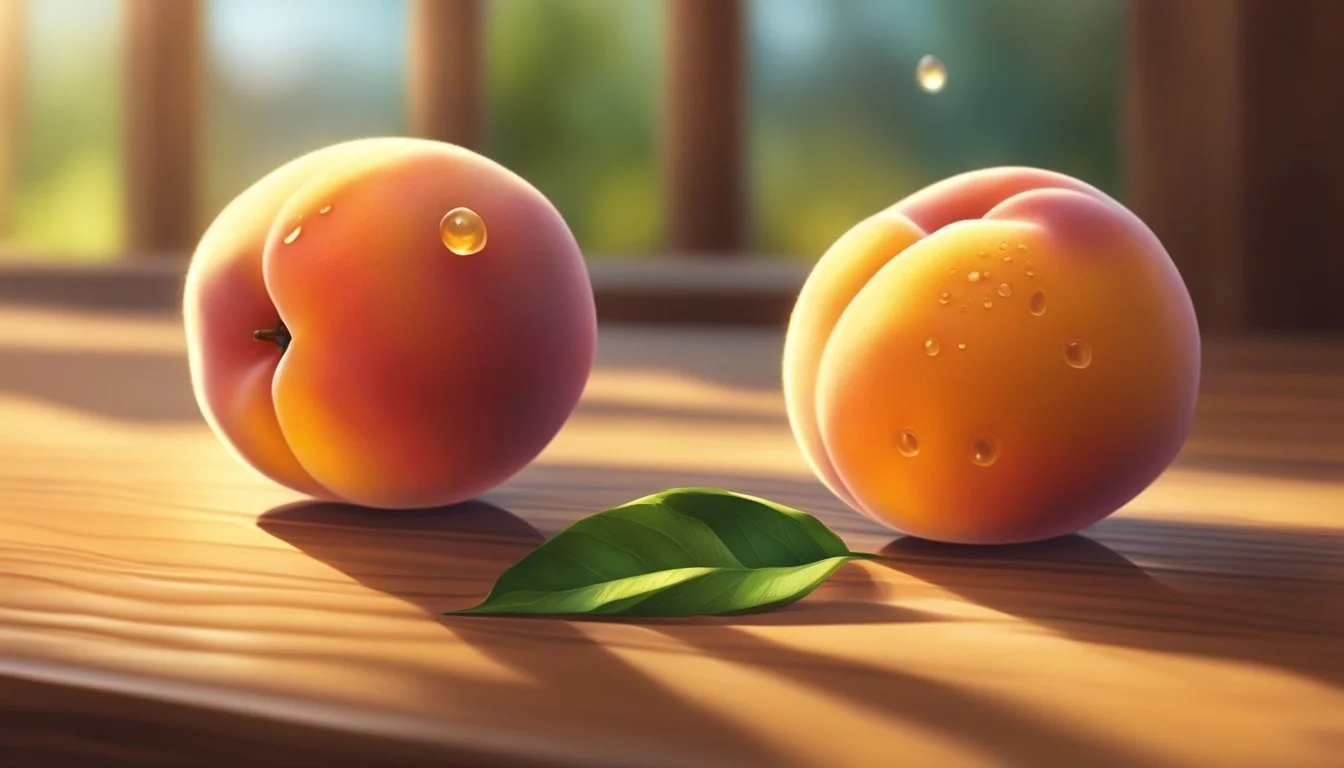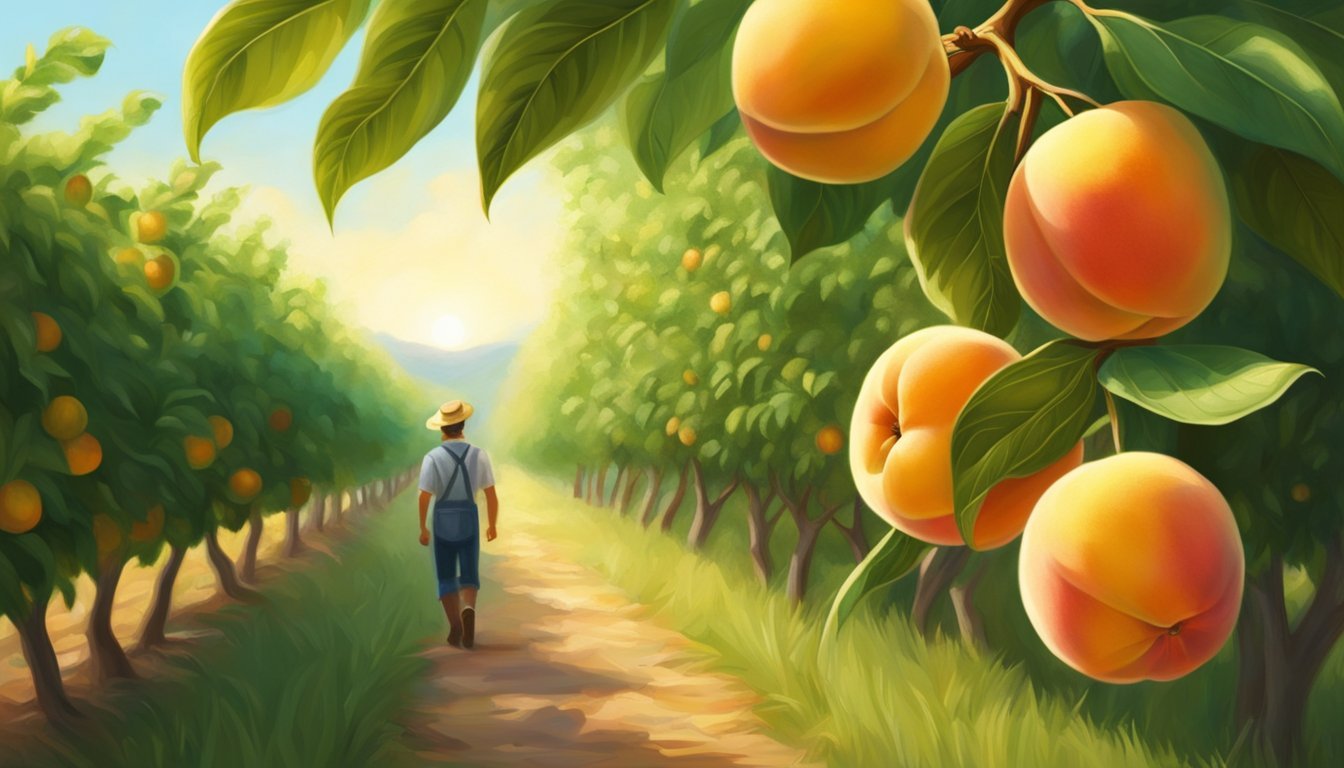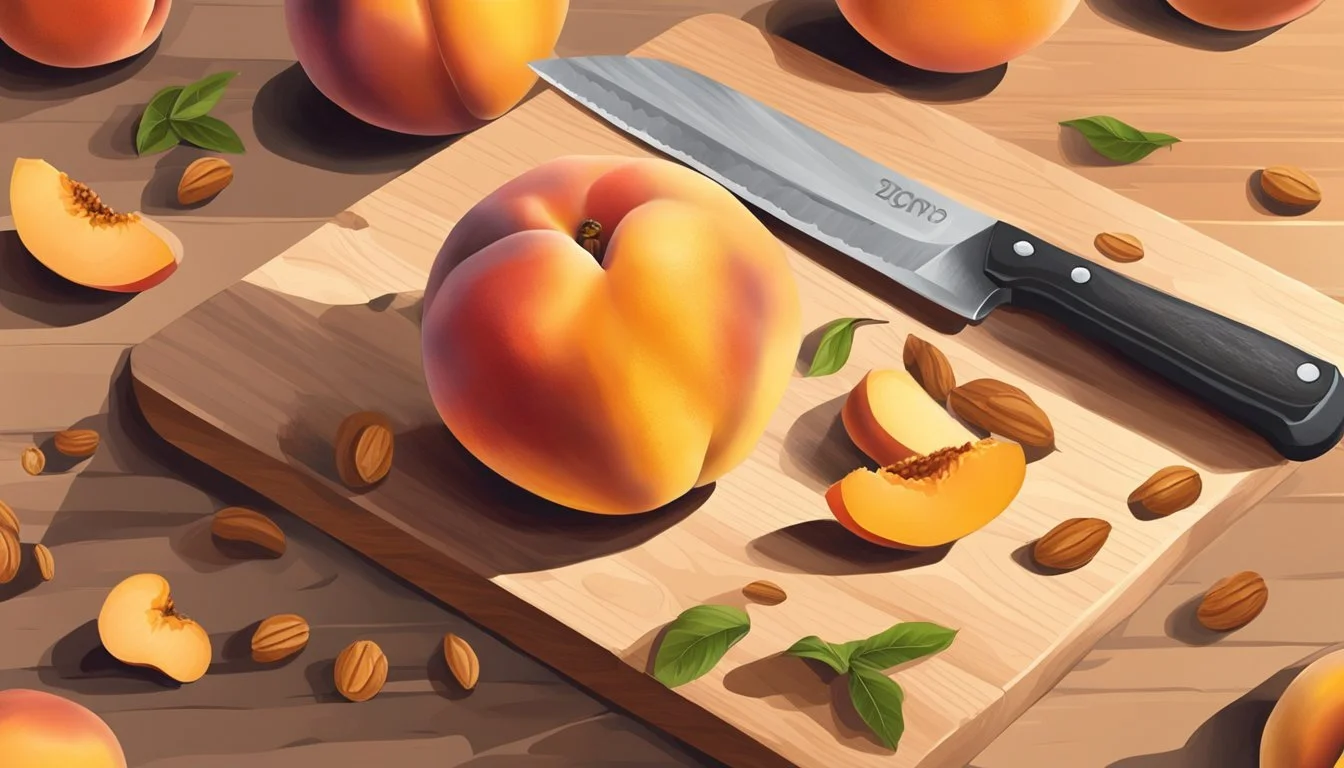How do you eat a peach?
Unveiling the Best Techniques for Enjoying This Juicy Fruit
Peaches are a hallmark of summer, symbolizing the season's abundance with their juicy sweetness and soft, fuzzy skins. This stone fruit (What wine goes well with fruit?) is not only a delicious treat but also versatile in the culinary world, making appearances in everything from fresh salads to decadent desserts. Knowing the best way to enjoy a peach can enhance the experience, whether one is relishing the fruit's natural flavor or incorporating it into a recipe.
When it comes to eating a peach, there is a spectrum of approaches ranging from casual to sophisticated. One could simply grab a ripe peach and eat it as is, perhaps over a sink to catch the dribbles of juice, which is an experience many look forward to as the weather warms. On the other hand, peaches can be sliced and served with complementary flavors, such as a dollop of vanilla ice cream or a drizzle of raspberry sauce, displaying their ability to mingle well with other tastes and textures. For those who prefer a more refined preparation, baking the fruit can enhance its natural sugars and provide a comforting dessert option.
Regardless of the chosen method, selecting a ripe peach is crucial. They should give slightly under a gentle squeeze, indicating softness without being mushy. Ripe peaches boast a sweet fragrance that hints at the flavor within and should be enjoyed promptly or stored carefully to preserve their quality. If they are not quite ripe, placing them in a paper bag can expedite the ripening process, allowing one to enjoy the full spectrum of the peach's potential.
Selecting the Perfect Peach
When looking for the perfect peach, one must consider ripeness indicators and understand the range of peach varieties to ensure the best selection.
Examining Ripe Peaches
To identify a ripe peach, one should assess several physical attributes. Touch is critical; a ripe peach will yield slightly to gentle pressure, indicating softness without being mushy. The color should be vibrant, with a deep yellow or cream background and a characteristic blush depending on the variety. Peaches should not only look good but also smell sweet and fragrant. One should avoid peaches with green areas as they may be underripe, and steer clear of any with bruises or overly soft spots, which can suggest overripeness or decay.
Understanding Peach Varieties
Peaches come in many varieties, which can be categorized based on the flesh around the pit, known as the stone. The main types are:
Clingstone peaches: The flesh clings to the pit, making them harder to pit but often juicier.
Freestone peaches: The flesh easily separates from the stone, making them convenient for eating fresh or using in recipes.
The specific variety of peach can affect its color, texture, and flavor, with various variaties better suited for canning, baking, or eating fresh. Knowing the type of peach varieties can greatly enhance the selection process.
Storing Peaches Properly
Ensuring peaches are stored correctly is crucial for maintaining their flavor and preventing spoilage. Delicate care can prolong their shelf life and keep bacteria at bay, allowing one to enjoy the fruit in its best condition.
At Room Temperature
One should store unripe peaches at room temperature, away from direct sunlight, to allow them to ripen naturally. This process is typically expedited when the peaches are placed in a paper bag, as the bag traps ethylene gas produced by the fruit, enhancing the ripening process. Frequent checking is recommended to prevent over-ripening, which can lead to bruises and rot.
In the Refrigerator
Once peaches reach their peak ripeness, they can be transferred to the fridge to slow further ripening. The cold environment of the refrigerator helps keep ripe peaches fresh for a few days, typically up to a week. However, they should be stored in a manner that minimizes moisture to prevent mold growth—storing them in a single layer on a shelf is ideal. As refrigeration can dehydrate, one must regularly check for signs of drying or wrinkling skin.
Extending Peach Freshness
To extend the freshness of peaches beyond immediate consumption, there are techniques such as freezing. For this method, one should:
Wash the peaches thoroughly.
Cut them into slices or wedges, removing any bruises.
Lay them flat on a baking sheet and freeze until solid.
Transfer the frozen peach pieces into airtight bags or containers to prevent freezer burn.
Another recommended approach is canning, which can preserve peaches for months. This method involves sterilizing canning jars, preparing peach slices or halves in syrup, and processing in a water bath to seal and protect the fruit from bacteria.
Preparation Techniques
Preparing a peach for eating can be quick and simple. Whether one chooses to slice, peel, or eat the peach with the skin on, following a few key steps ensures the peach is ready for consumption.
Washing and Drying
To start, one should wash the peach under running water to remove any dirt or residue from the skin. It's important to be gentle to not bruise the ripe fruit. Once washed, the peach should be dried with a clean towel to prevent slipping when slicing.
Slicing Peaches
Using a sharp knife, one can make a circular cut around the pit, starting at the stem and following the peach's crease. Then, by twisting the halves in opposite directions, they can easily separate the peach into two pieces. If one wishes to create smaller slices, they can cut each half into wedges away from the pit.
To Peel or Not to Peel
The decision to peel a peach is a matter of personal preference. Ripe peaches often have a fuzzy skin that some may choose to remove. To peel, one can either use a paring knife to gently lift the skin away or blanch the peach in boiling water for a minute to loosen the skin for easier removal. After blanching, place the peach in ice water to halt the cooking process, making the skin simple to peel away.
Ways to Enjoy Peaches
Peaches are incredibly versatile and can be enjoyed in a myriad of ways, from fresh and raw to cooked and incorporated into various dishes. Each method highlights the peach's natural sweetness and can complement both sweet and savory flavors.
Raw Consumption
Eating peaches raw captures their natural flavor and juiciness at its peak. One can simply wash the peach, remove the pit, and enjoy each bite as is, with the juices freely flowing, possibly over the kitchen sink to avoid any mess. For a more enhanced experience, slices of peach can be added to yogurt or oatmeal for breakfast. They also blend beautifully into smoothies for a refreshing treat.
Cooked Delights
Cooking peaches transforms their flavor and texture, bringing out a richer, more caramelized profile. Grilled peaches are a simple delicacy; just slice them in half, remove the pit, and place them on a grill until charred lines appear. Baked peaches can be savored in desserts like cobblers or peach pie. This fruit also makes for a delicious jam or can be a sweet addition to ice cream.
Peach in Salads and Breakfasts
Peaches add a sweet note to salads, combining well with leafy greens, nuts, and cheeses with a drizzle of vinaigrette. They contribute to a flavorful balance in salsa that pairs exceptionally well with grilled meats or fish. During breakfast, diced peaches can be tossed into oatmeal or a bowl of cereal, layered with yogurt, or used to top off pancakes and waffles, often with a sprinkle of cinnamon for that extra zing.
Preserving Peaches
Preserving peaches allows individuals to enjoy the succulent fruit all year round. Whether one prefers them canned for a classic treat, frozen for convenience, or transformed into delectable jams and pies, the process of preservation extends the life of peaches beyond their fresh season.
Canning Peaches
When canning peaches, it is essential to start by peeling the fruit. The most straightforward method to remove their skins is the blanching technique, where peaches are submerged in boiling water for about one minute and then immediately placed in cold water. After the skins slip off easily, the peaches can be canned whole or sliced, preserved in a syrup made from sugar and water.
Freezing Practices
To freeze peaches, they should first be washed, pitted, and sliced. Prevent browning by soaking the slices in a lemon juice and water solution. For optimal quality:
Arrange the peach slices on a parchment-lined baking sheet.
Freeze the peaches until solid to prevent the slices from clumping together.
Transfer the frozen peach slices into an airtight container or freezer bag, labeled with the date.
Making Jams and Pies
Peaches can be transformed into delicious jams with sugar and pectin, cooked until they reach the desired consistency. For peach pie and tarts, use fresh or preserved peaches to fill your pastry shells. When using frozen peaches in pies, there’s no need to thaw them, which avoids excess moisture in the filling.
Nutritional Benefits and Health Implications
Peaches are celebrated for their rich nutritional profile and their potential to support health and combat disease. Loaded with essential nutrients and a host of antioxidants, peaches can be a sweet addition to a balanced diet.
Vitamins and Antioxidants
Peaches are laden with a variety of vitamins, particularly vitamin C, which is crucial for skin health, immune system function, and the repair of tissues. They also contain antioxidants such as beta-carotene, converting to vitamin A in the body and promoting healthy vision. The presence of these antioxidants means peaches can help neutralize free radicals, potentially reducing the risk of aging and chronic diseases like cancer.
Vitamin C: Important for skin health and immune function
Beta-Carotene: Converts to vitamin A, essential for eyesight
Antioxidants: Combat oxidative stress, may reduce disease risk
Fiber and Digestion
The fiber in peaches comes in two forms: soluble and insoluble. Soluble fiber helps to stabilize blood sugar levels and maintain healthy cholesterol levels, while insoluble fiber aids in digestion and prevents constipation. This balanced fiber content can also play a role in managing high blood pressure and contributing to overall heart health.
Soluble Fiber: For blood sugar control and cholesterol management
Insoluble Fiber: Helps with digestion and prevents constipation
Peaches in a Healthy Diet
A medium-sized peach is relatively low in calories, making it an excellent option for those monitoring their calorie intake. Peaches are also a source of minerals like potassium and iron. Potassium is known to help control blood pressure and is also linked to reduced risks of heart disease. Iron is essential for oxygen transport in the blood. Incorporating peaches into one's diet can contribute to these nutritional needs while supporting a heart-healthy diet.
Low Calories: Suitable for weight management
Potassium: Helps manage blood pressure, supports heart health
Iron: Essential for oxygen transport in the bloodstream
Understanding Peach Cultivation
Cultivating peaches (Prunus persica) involves knowledge of the tree's preferred growth conditions, regional variances in production, and the timing of the harvest season.
Peach Trees and Growth Conditions
Peach trees thrive in regions that provide a chilling period essential for dormancy, followed by a warm spring and hot summer conducive to fruit development. They grow best in well-drained, fertile soil with full sun exposure, requiring at least six hours of direct sunlight daily. Peach trees are grown in USDA Zones 4 to 10, but they flourish particularly in Zones 6 to 8.
Harvesting and Seasonality
The peach season typically ranges from late May to early September in the Northern Hemisphere. The actual time for harvesting depends on the variety of peach and local climatic conditions. Peaches should be harvested when they are fully ripe, characterized by a background color change from green to yellow or cream, a sweet fragrance, and slightly soft flesh.
Peach Production by Region
Peach production varies globally, with China leading as the largest producer. In the United States, California and Georgia are the top peach-producing states, offering different varieties tailored to their specific microclimates. Italy also holds a significant place in peach cultivation within Europe, focusing on high-quality fruit production.
China: Largest producer of peaches worldwide.
United States: California and Georgia are key producers.
Italy: Known for high-quality peach production.
Peaches, as a stone fruit, require attentive cultivation practices tailored to their growth conditions, regional climates, and market demands to ensure successful production and fruit quality.
Culinary Inspirations
In the world of peaches, the ripe fruit offers a versatile palette for both sweet and savory culinary creations, lending itself to a variety of recipes and pairings.
Peach Recipes
One can transform peaches into delightful desserts, such as peach cobbler, where the fruit's sweetness is complemented by a crumbly, buttery topping. The process often involves:
Slicing peaches and laying them in a baking dish
Mixing with sugar, and spices like cinnamon
Covering with a biscuit or dough topping
Baking until golden and bubbly
For a refreshing option, peaches contribute to a nutrient-packed smoothie by blending:
Fresh or frozen peaches
A choice of cream or a dairy-free alternative
Additional fruits like berries or bananas for extra flavor
Pairing Peaches with Other Foods
Peaches pair exceptionally well with a range of other fruits and dairy products. A classic combination is peaches and cream, where the fruit's juiciness contrasts beautifully with the richness of the cream.
A summer fruit salad may include peaches alongside:
Nectarines: similar in flavor but with a smooth skin
Apricots: adding a tangy note
Plums: providing depth to the dish
Cherries: contributing a pop of color and tartness
Berries: for added sweetness and complexity
These ingredients can be mixed to create a colorful and healthy dish that's ideal for any summer gathering.
Peach Facts and History
The peach, scientifically named Prunus persica, is a stone fruit native to China that has been cultivated for thousands of years. Today, it is a popular fruit grown in temperate regions globally, with the United States, particularly California and Georgia, playing significant roles in production.
Historical Significance
China: Known as the land of origin, it is here that peaches began their journey over 3,000 years ago. This stone fruit rapidly found its way along trade routes, influencing cuisine and culture as it spread.
United States: By the 19th century, peaches had become an integral part of American agriculture. States like California and Georgia emerged as leading producers. Georgia, often recognized as the "Peach State," signifies its pivotal role in the peach industry.
Peach Fun Facts
Prunus Persica: Relates to the peach's scientific name, which translates to "Persian plum" from Latin, indicating the historical misconception that peaches originated from Persia.
Experience: The act of eating a peach is often associated with sensory pleasure due to its delicate aroma and juicy flesh. This has permeated into phrases suggesting positivity such as "peachy keen."
Variety Description Common Usage Clingstone Flesh clings to the pit Often used in canning Freestone Flesh separates easily from the pit Preferred for fresh eating and baking
Additional Tips and Warnings
When enjoying peaches, it's important to consider potential chemical exposure and recognize any food sensitivities or allergic reactions. Adequate steps should be taken to reduce the risk associated with both.
Avoiding Pesticides and Chemicals
Peaches can be exposed to pesticides and other chemicals during their growing process. To reduce the risk of ingestion of these substances, consumers should:
Thoroughly wash peaches under running water before consumption. This helps remove any residues on the surface.
Consider buying organic peaches which typically have lower pesticide levels. Organic farming standards promote the use of natural substances and physical, mechanical, or biologically based farming methods to the fullest extent possible.
Peel the skin off the peaches if the consumer is particularly concerned about pesticides, although this may also remove some of the fruit's nutrients.
Identifying Peach Allergies
Peaches contain proteins that can trigger allergic reactions in some individuals. To identify and manage peach allergies, one should:
Pay attention to the body's response after eating peaches for the first time or after a prolonged period without consumption. Symptoms of an allergy can include itchiness, swelling, difficulty breathing, or a rash.
Consult a medical professional for testing if an allergy is suspected. This is crucial for proper diagnosis and management.
For individuals with a known allergy, ensure they read food labels carefully, as peach ingredients may be present in unexpected products.
Troubleshooting Common Peach Issues
When dealing with peaches, one needs to pay attention to their ripeness and signs of any pest damage. By knowing how to handle overripe peaches and mitigate pest problems, one can enjoy fresh, delicious fruit without unnecessary waste or quality issues.
Dealing with Overripe Peaches
An overripe peach can complicate the eating experience due to a mushy texture and potential for increased bacteria. If a peach has proceeded past the point of optimal ripeness, it can still be salvaged for consumption. Overripe peaches are perfect for recipes like smoothies, jams, or baking, where their softer texture and heightened sweetness can be an advantage.
Steps to Utilize Overripe Peaches:
Smoothies: Blend overripe peaches for a naturally sweet smoothie addition.
Baking: Use them in pies, cobblers, or compotes where the texture is less critical.
Jam: Cook down overripe peaches with sugar to make a sweet preserve.
Storage Tip: To extend the life of an overripe peach, store it in the refrigerator, but be sure to use it within a day or two to prevent further decay and potential rot.
Preventing and Recognizing Pest Damage
Peaches are susceptible to pest damage from insects like the plum curculio and diseases such as brown rot. Preventing pest damage begins with regular monitoring and early detection. If one identifies a worm in the peach, it often indicates the presence of pests like the plum curculio.
Pest Management Strategies:
Regular Inspection: Check peaches frequently for signs of insects and bruises which can lead to bacteria and rot.
Organic Sprays: For pest control, some organic options may be available; consult a local agricultural extension for recommendations suitable for your regional climate.
Signs of a Pest-Infected Peach:
Holes or bruises on the fruit's surface.
The presence of larvae inside the fruit.
Soft spots which may indicate the onset of rot and a possible entry point for pests.
Final Thoughts on Peach Consumption
Eating a peach is a simple yet delightful culinary experience. They should consider the ripe fruit's soft texture and the sweet, fragrant aroma that signifies readiness for consumption. To properly eat a peach, they may want to wash the fruit first to clean off any residues.
One might enjoy a peach raw, savoring the natural flavor that comes from the juicy flesh. A gentle bite reveals the tender texture that peaches are famed for, and each bite releases bursts of sweetness with subtle acidity that can enhance the overall taste.
For those who enjoy cooking, peaches offer versatility. Whether baked into pies or blended into a refreshing summer sauce, the essence of the peach is robust enough to pair with a variety of ingredients. Poaching peaches in light syrup can intensify their flavor and provide a different experience compared to consuming them raw.
Preparation Methods:
Raw: Eat as is or slice and enjoy with or without the skin.
Baked: Incorporated into desserts for a warm, comforting treat.
Blended: Transformed into sauces or smoothies to highlight their flavor.
Peaches can be a healthful addition to one's diet, with a plethora of nutrients and fiber. They should consume peaches in moderation and explore the fruit's potential combination with other foods to agree with one's personal taste preference and dietary needs. The experience of eating peaches is one that embraces the senses, and one should relish both the process and the moment.







